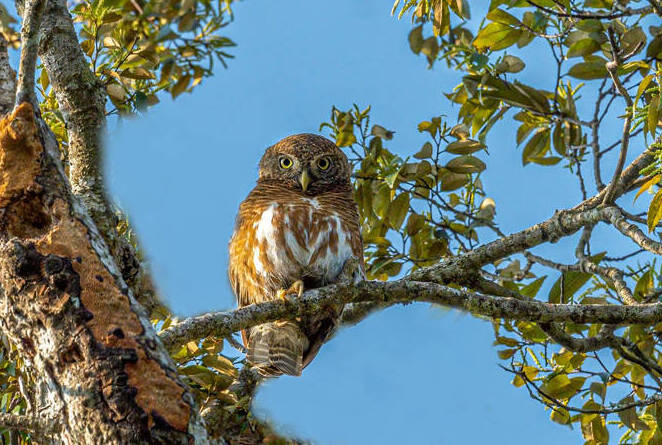Glaucidium cuculoides
IUCN
LCBasic Information
Scientific classification
- name:Glaucidium cuculoides
- Scientific Name:Glaucidium cuculoides,Asian Barred Owlet,Little Owl, King Cat Bird, Fox Training, Wandering
- Outline:Raptor
- Family:Strigiformes Ostridae Owl
Vital signs
- length:24-26cm
- Weight:150-260g
- lifetime:About 10-20 years
Feature
There is a prominent white spot on the throat, which can produce a double whistle sound like a dog's bark.
Distribution and Habitat
The spotted owl is distributed in southern Gansu, Shaanxi, Henan, Anhui, Sichuan, Guizhou, Yunnan, Tibet, Guangxi, Guangdong, Hong Kong and Hainan Island in China. Outside China, it is distributed in India, Nepal, Sikkim, Bhutan, Myanmar, Thailand, Indochina, Malaysia and Indonesia.
The spotted owl inhabits broad-leaved forests, mixed forests, secondary forests and forest edge shrubs in plains, low hills and mid-mountain areas with an altitude of about 2,000 meters. It also appears in sparse forests and trees near villages and farmlands.
Appearance
The head, neck and entire upper body of the Spotted Owl, including the wings, are dark brown and densely covered with narrow brown-white horizontal spots, especially the horizontal spots on the top of the head are particularly small and dense. The eyebrow lines are white, short and narrow. There are large white spots on part of the shoulder feathers and outer covert feathers, the flight feathers are dark brown, the outer feathers are decorated with brown or brown-white triangular feather edge spots, and the inner feathers have horizontal spots of the same color; the third-level flight feathers have horizontal spots on both the inner and outer feathers; The tail feathers are dark brown, with 6 obvious white horizontal spots and feather end spots; the chin and jaw lines are white, the middle part of the throat is brown, and the skin has yellow horizontal spots; the lower throat and upper chest are white, and the lower chest is white with brown horizontal spots; The belly is white with br
Details
Asian Barred Owlet is a small owl with 8 subspecies.

Asian Barred Owlet is a resident bird, mostly alone or in pairs. Most of them are active and foraging during the day. They can catch small birds and large insects in the air like eagles, and are also active at night. They mainly feed on various insects and larvae such as locusts, beetles, mantises, cicadas, crickets, ants, dragonflies, caterpillars, etc., and also eat animals such as rodents, small birds, earthworms, frogs and lizards. The call is loud and clear. Unlike other owls, it emits a fast trill at dawn and dusk, and the pitch is lowered and the volume increases. It also emits a double whistle sound similar to a dog's bark, which increases in volume and speed, and repeats repeatedly until the full sound. In a quiet night, it can be heard several miles away.
The breeding season of the spotted owl is between March and June. It usually nests in tree holes or natural caves. Each nest lays 3-5 eggs, most of which are 4, occasionally as many as 8-9 and as few as 3. The size of the eggs is 33-39 mm × 29-32 mm, with an average of 36.5 mm-30.5 mm. The eggs are white. The female bird is responsible for incubation, and the incubation period is 28-29 days.
The distribution range of the spotted owl is wide, and it is not close to the vulnerable and endangered critical value standard for species survival (distribution area or fluctuation range less than 20,000 km², habitat quality, population size, and fragmentation of distribution area). The population trend is rising, so it is evaluated as a species of least concern.
The population of the spotted owl in China is estimated to be 10,000-100,000 breeding pairs.
On May 13, 2022, a resident of Sukeng Town, Yongchun County, found a young owl that had fallen to the ground. It was a spotted owl.
The spotted owl has been listed in the 2012 Red List of Endangered Species of the World Conservation Union (IUCN) ver 3.1-Least Concern (LC).
The spotted owl has been listed as a Class II protected animal in the "National Key Protected Wildlife List" issued by the Ministry of Forestry and the Ministry of Agriculture of China on January 14, 1989.
Protect wild animals and stop eating game.
Maintaining ecological balance is everyone's responsibility!








